Our guide, Mu Mu, wrinkled up her nose when she learned I planned to take the Circular Train in Yangon. “It is not very comfortable,” she said. “Hard to go to the bathroom and takes a long time.” It sounded perfect to me.
Later that morning, I traipsed through the mud to a dilapidated ticket window in a dingy train station where chickens roamed, only to discover I was on the wrong side of the tracks. By the time I had located the correct platform, the train whistle was blowing, so I hastily paid my 20 cents and ran for the carriages. With no pass-through available between cars, I checked for an available seat before climbing aboard. I finally found one in the fourth carriage and settled into the hard wooden bench just as we jolted out of the station.
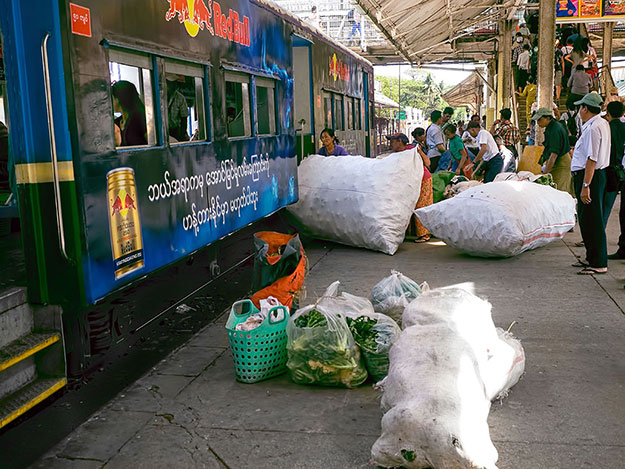
Now it was my turn to wrinkle up my nose; the stench that permeated the car was equal parts stinky feet, stale urine, and sewage. The breeze through the open windows did nothing to reduce it, and I realized the smell emanated from the surrounding land, where squatters had constructed shacks of woven bamboo and corrugated tin sheets. Lacking sanitation facilities or city services, land along the tracks was serving as both toilet and dump. The poverty that unfolded as we rolled lazily along was pervasive but not startling. Myanmar emerged from an oppressive military dictatorship in 2010 and economic sanctions are still being imposed by some countries, including the United States. Though conditions are improving rapidly, the majority of the population still lives below the poverty level, earning on average only $100 to $300 per month.
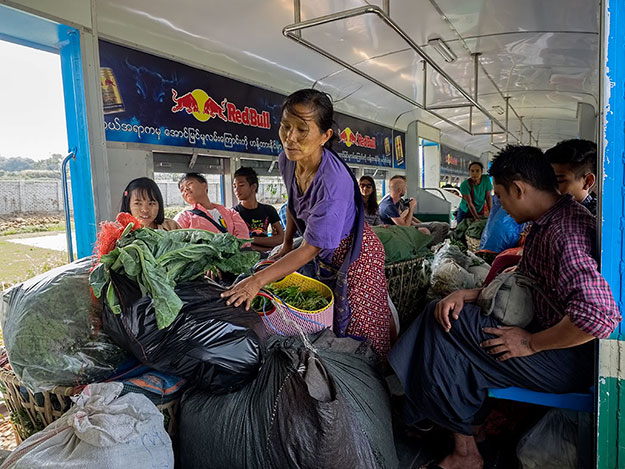
Halfway into the trip, we pulled into Danyingon station. Unlike other sleepy stops in the countryside, this one was a beehive of activity. Even before the train stopped, men and women dressed in long tubes of patterned fabric known as longyis were hefting huge bundles of fresh produce into the car. Within moments, my feet were wedged between two huge parcels.
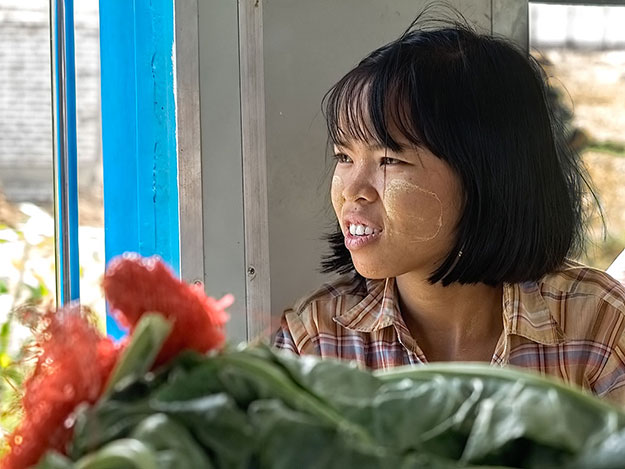
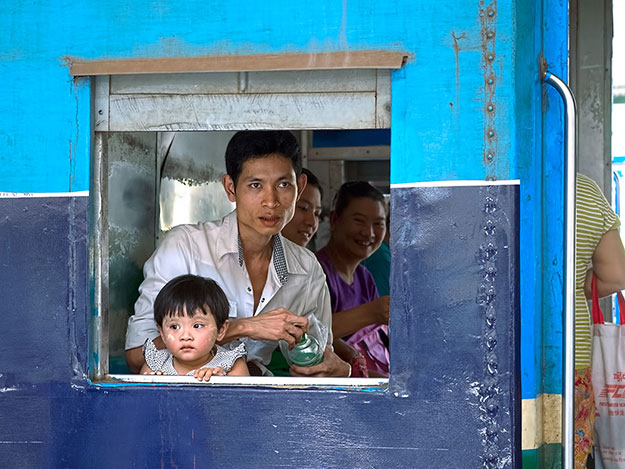
Smiling their toothy white smiles, the vendors piled bag upon bag, until I was sure the towers would topple. As we got underway again, they wedged into chinks of floor space or balanced precariously on top of the stacks, sticking their bare feet out of the carriage windows. Women with faces painted in Thnakha paste as protection from the sun teased the young men, who responded with raucous laughter as they peeled and rubber-banded bunches of broccoli, kailan, and Morning Glory.
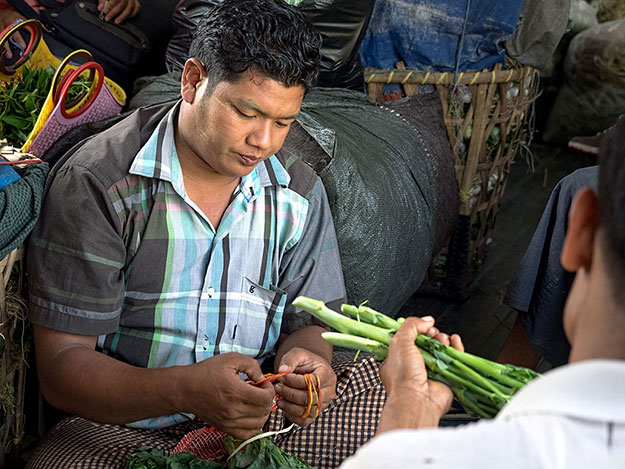
We had left the city behind by that time. All manner of leafy green vegetables were being grown on patchwork plots separated by earthen mounds. In flooded paddies, women wearing conical straw hats stood waist deep in the water or squatted between the rows, pulling weeds. Though the population of the two largest cities, Yangon and Mandalay, have swelled in recent years, 70 percent of Myanmar’s 52 million citizens still live in countryside, where electricity and running water are luxuries and roads are little more than dirt tracks. Without the Circular Train, rural residents would have little access to medical services, store-bought goods, or markets where they sell their farm-grown products.
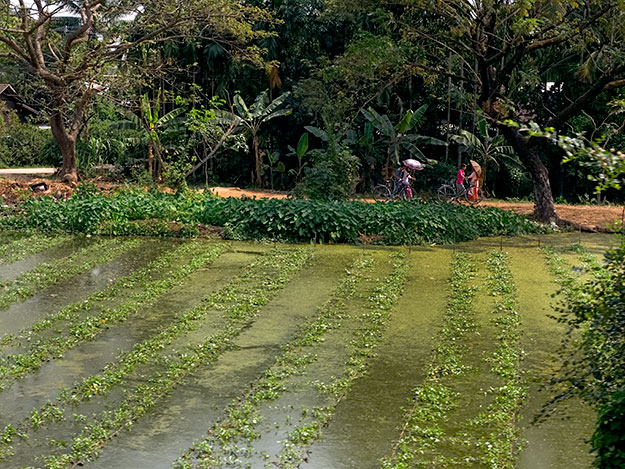
At the halfway point in its journey, the Circular Train rounded the northern edge of the airport and headed back toward Yangon through fields shimmering in the midday heat. Gradually, open land fell away and the city began to reappear. When we finally returned to Yangon Central Station, I climbed down gingerly from the carriage. On one hand, I was relieved to be done with the hard bench that had battered my back for 2.5 hour ride, and my nose was certainly happier. On the other hand, I’d do it all over again in an instant.
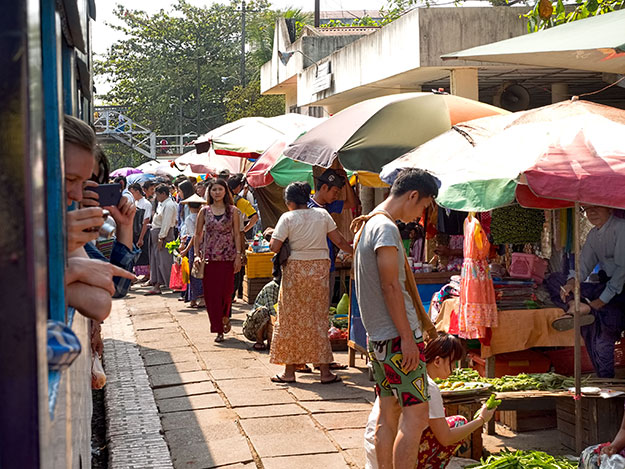
Disclosure: Viking River Cruises sponsored me on their Myanmar Explorer cruise/tour however the receipt and acceptance of complimentary items or services will never influence the content, topics, or posts in this blog. I write the truth, the whole truth, and nothing but the truth, and the truth that Viking River does a fabulous job with their tour/cruises.

What a great experience you had omg I seems similar thinks bit in buses in central América never in trains
LOL – it was my first experience like this on a train as well.
These experiences are so interesting. I love train travel, not just because it is a relaxing way to travel and a good way to see the scenery of a place, but because you get to have a truly local experience. This looks wonderful to me. I love how the train is full of vegetables and everything else that they locals want to load on. So very Asia 🙂
Hi David: It was just by accident that I ended up n the local carriage rather than the “ordinary” carriage, but those are the kid of mistakes/experiences that make for a lifetime of storytelling. And you so correct – it is SO Asia.
Sounds like one of those experiences that gives you a unique glimpse into the heart of a community. Thanks for sharing!
It definitely did, Sarah. It was right at the beginning of my trip, so it set the tone for the entire experience.
What an amazing (if uncomfortable) experience … would love to do the same when I get to Myanmar!
Oh, DO take the train when you visit, Kristen. It was a wonderful adventure.